看图学源码之FutureTask
2023-12-24 23:28:40
RunnableFuture
源码学习:
成员变量
任务的运行状态的转化
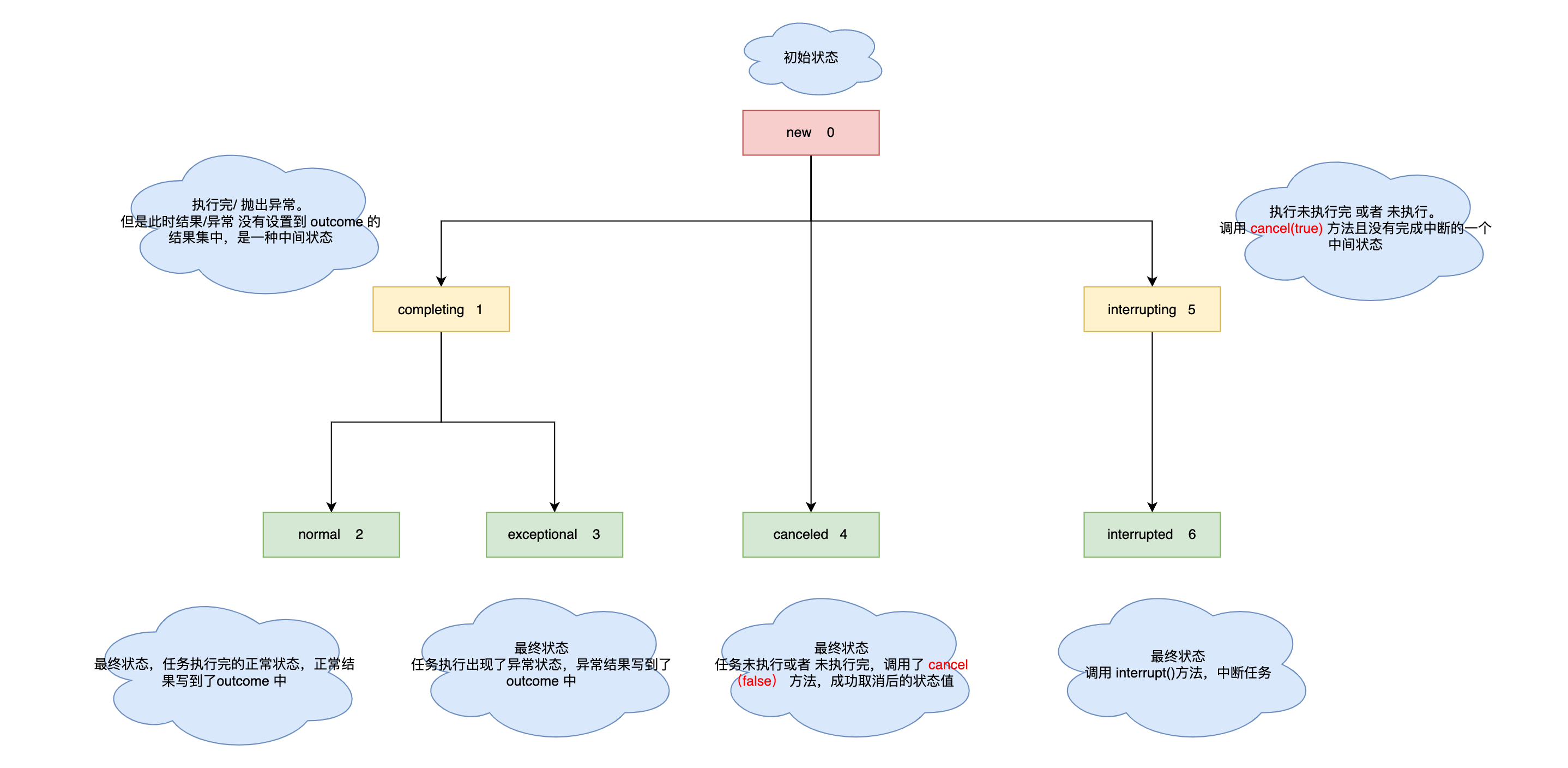
package java.util.concurrent;
import java.util.concurrent.locks.LockSupport;
/**
可取消的异步计算。
该类提供了Future的基本实现,包括启动和取消计算的方法,查询计算是否完成以及获取计算结果的方法。只有在计算完成后才能获取结果;如果计算尚未完成,get方法将会阻塞。一旦计算完成,就无法重新启动或取消计算(除非使用runAndReset方法调用计算)。
FutureTask可以用来包装一个Callable或Runnable对象。由于FutureTask实现了Runnable接口,因此可以将FutureTask提交给Executor执行。 除了作为独立的类使用外,该类还提供了一些受保护的功能,这些功能在创建自定义任务类时可能会有用。
*/
public class FutureTask<V> implements RunnableFuture<V> {
/**
此任务的运行状态,初始为NEW。运行状态仅在set、setException和cancel方法中转换为终态。
在完成过程中,状态可能会暂时变为COMPLETING(在设置结果时)或INTERRUPTING(仅在中断执行者以满足cancel(true)时)。
从这些中间状态到最终状态的转换使用更便宜的有序/懒惰写入,因为这些值是唯一的且不会进一步修改。
* Possible state transitions:
* NEW -> COMPLETING -> NORMAL 正常结束
* NEW -> COMPLETING -> EXCEPTIONAL 异常结束
* NEW -> CANCELLED
* NEW -> INTERRUPTING -> INTERRUPTED
*/
// 状态值: 表示任务运行的状态
private volatile int state;
// 新建 或者 正在运行
private static final int NEW = 0;
// 中间状态(任务执行完了,但是结果集(正结果/ 异常) 没有设置到 outcome)
private static final int COMPLETING = 1;
// 正常执行完成(结果集设置到outcome之后,正常结束)
private static final int NORMAL = 2;
// 异常执行完成(结果集设置到outcome之后,异常结束)
private static final int EXCEPTIONAL = 3;
// 取消
private static final int CANCELLED = 4;
// 中断(中间值)[但是还没有中断]
private static final int INTERRUPTING = 5;
// 中断完成,最终状态
private static final int INTERRUPTED = 6;
/** The underlying callable; nulled out after running */
// 执行目标
private Callable<V> callable;
/** The result to return or exception to throw from get() */
// 结果集
private Object outcome; // non-volatile, protected by state reads/writes
/** The thread running the callable; CASed during run() */
// 执行任务的线程
private volatile Thread runner;
/** Treiber stack of waiting threads */
// get 阻塞的时候,使用 WaitNode{物理结构:链表;逻辑结构:栈}去存储阻塞的线程
private volatile WaitNode waiters;
public FutureTask(Callable<V> callable) {
if (callable == null) throw new NullPointerException();
this.callable = callable;
this.state = NEW; // ensure visibility of callable
}
public FutureTask(Runnable runnable, V result) {
this.callable = Executors.callable(runnable, result); // 适配器的方式
this.state = NEW; // ensure visibility of callable
}
public boolean isCancelled() {
return state >= CANCELLED;
}
public boolean isDone() {
return state != NEW;
}
/**
* 简单的链表节点,用于记录Treiber堆栈中的等待线程。
*/
static final class WaitNode {
volatile Thread thread;
volatile WaitNode next;
WaitNode() { thread = Thread.currentThread(); }
}
// Unsafe mechanics
private static final sun.misc.Unsafe UNSAFE;
private static final long stateOffset;
private static final long runnerOffset;
private static final long waitersOffset;
static {
try {
UNSAFE = sun.misc.Unsafe.getUnsafe();
Class<?> k = FutureTask.class;
stateOffset = UNSAFE.objectFieldOffset
(k.getDeclaredField("state"));
runnerOffset = UNSAFE.objectFieldOffset
(k.getDeclaredField("runner"));
waitersOffset = UNSAFE.objectFieldOffset
(k.getDeclaredField("waiters"));
} catch (Exception e) {
throw new Error(e);
}
}
}
run()
任务只能执行一次
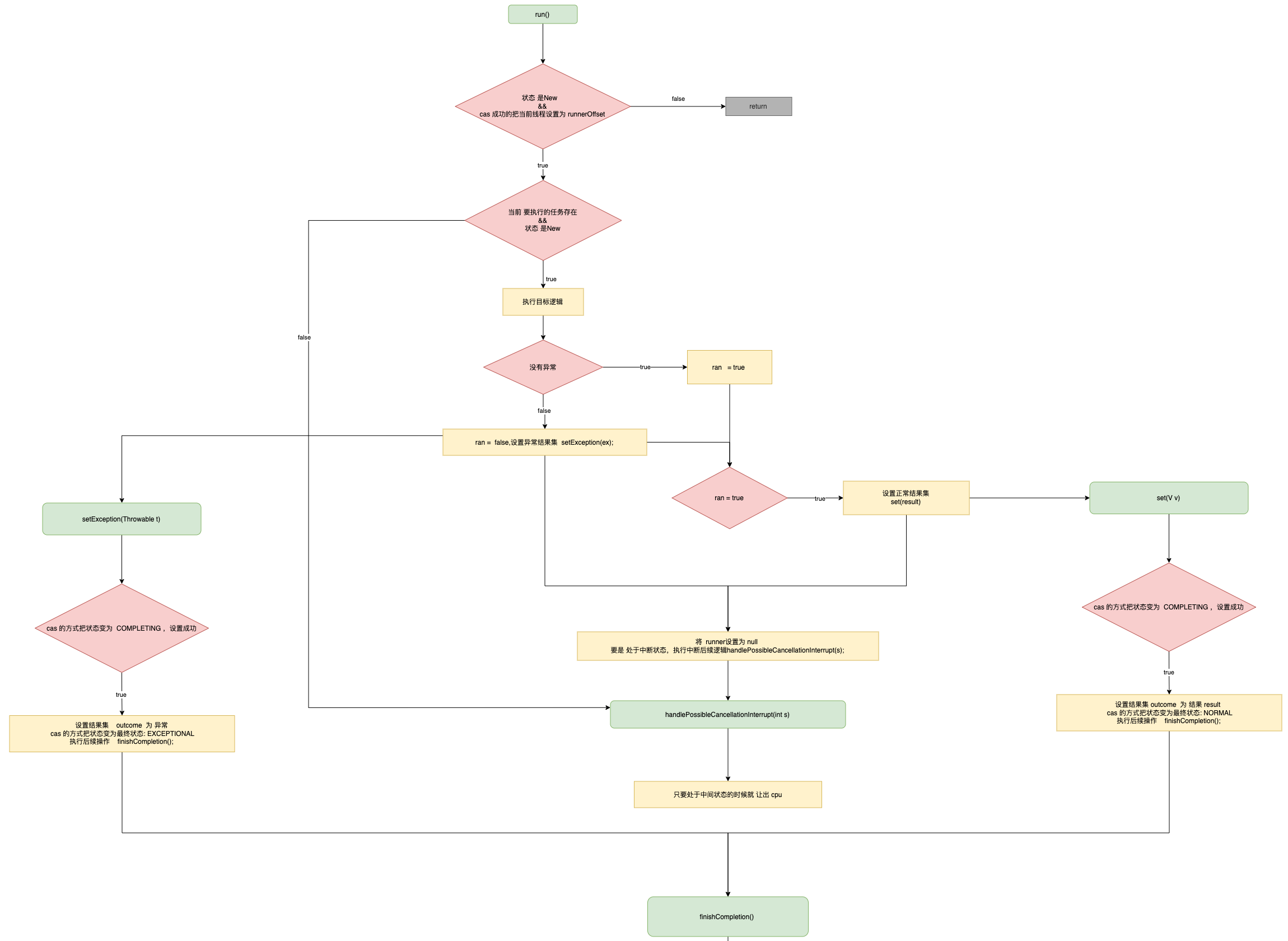
public void run() {
// 状态 是New 并且 cas 成功的把当前线程设置到 runner 才能执行后续的方法,否则就直接返回
if (state != NEW ||
!UNSAFE.compareAndSwapObject(this, runnerOffset,
null, Thread.currentThread()))
return;
try {
Callable<V> c = callable;
// 当前 要执行的任务存在,并且 状态 是New 才会调用目标逻辑 c.call()
if (c != null && state == NEW) {
V result;
boolean ran;
try {
result = c.call();
// 目标逻辑执行成功
ran = true;
} catch (Throwable ex) {
// 目标逻辑执行 失败 ,结果 置为 null
result = null;
ran = false;
// 设置异常结果集
setException(ex);
}
if (ran)
// 设置正常结果集
set(result);
}
} finally {
// 在任务状态被确定之前,runner必须非空,以防止对run()方法的并发调用。
runner = null;
// 在将runner设置为null之后,必须重新读取任务的状态,以防止泄漏的中断。
int s = state;
if (s >= INTERRUPTING) // 处于中断状态,执行中断后续逻辑
handlePossibleCancellationInterrupt(s);
}
}
@FunctionalInterface
public interface Callable<V> {
V call() throws Exception;
}
/*
将此Future的结果设置为给定的值,除非此Future已经被设置或已取消。在计算成功完成时,此方法由run方法在内部调用。
*/
protected void set(V v) {
// cas 的方式把状态变为 COMPLETING ,设置成功
if (UNSAFE.compareAndSwapInt(this, stateOffset, NEW, COMPLETING)) {
// 设置结果集为 结果 result
outcome = v;
// cas 的方式把状态变为最终状态: NORMAL
UNSAFE.putOrderedInt(this, stateOffset, NORMAL); // final state
// 执行后续操作
finishCompletion();
}
}
/*
将此Future报告为ExecutionException,将给定的throwable作为其原因,除非此Future已经被设置或已取消。在计算失败时,此方法由run方法在内部调用。
*/
protected void setException(Throwable t) {
// cas 的方式把状态变为 COMPLETING ,设置成功
if (UNSAFE.compareAndSwapInt(this, stateOffset, NEW, COMPLETING)) {
// 设置结果集为 异常
outcome = t;
// cas 的方式把状态变为最终状态: EXCEPTIONAL
UNSAFE.putOrderedInt(this, stateOffset, EXCEPTIONAL); // final state
// 执行后续操作
finishCompletion();
}
}
/*
确保任何来自可能的cancel(true)取消操作的中断仅在run或runAndReset方法中传递给任务的目的。
*/
private void handlePossibleCancellationInterrupt(int s) {
// 解释了在等待中断信号时使用自旋等待的目的: 通过中断来取消任务的执行。然而,可能存在一种情况,即中断线程在 有机会中断当前线程 之前被阻塞。为了等待中断信号的到来,代码使用了自旋等待的策略。
if (s == INTERRUPTING)
while (state == INTERRUPTING)
// 处于中间状态的时候就 让出 cpu
Thread.yield(); // wait out pending interrupt
// assert state == INTERRUPTED;
// 解释了在state等于INTERRUPTED时的处理逻辑
// 它使用断言(assert)来确保任务的状态为INTERRUPTED。断言通常用于在代码中插入一些检查,以确保某些条件为真。如果断言的条件为假,将会抛出一个AssertionError异常。
// Thread.interrupted();
// 解释了清除可能来自cancel(true)取消操作的中断的目的。但是,中断也可以作为一个独立的机制,用于任务与其调用者之间的通信,并且没有办法只清除取消中断。因此,为了清除中断,代码调用了Thread.interrupted()方法。
// Thread.interrupted()方法用于清除当前线程的中断状态,并返回之前的中断状态。这样做的目的是确保任务的中断状态被清除,以便后续的代码或操作不会受到中断的影响。
}
finishCompletion()
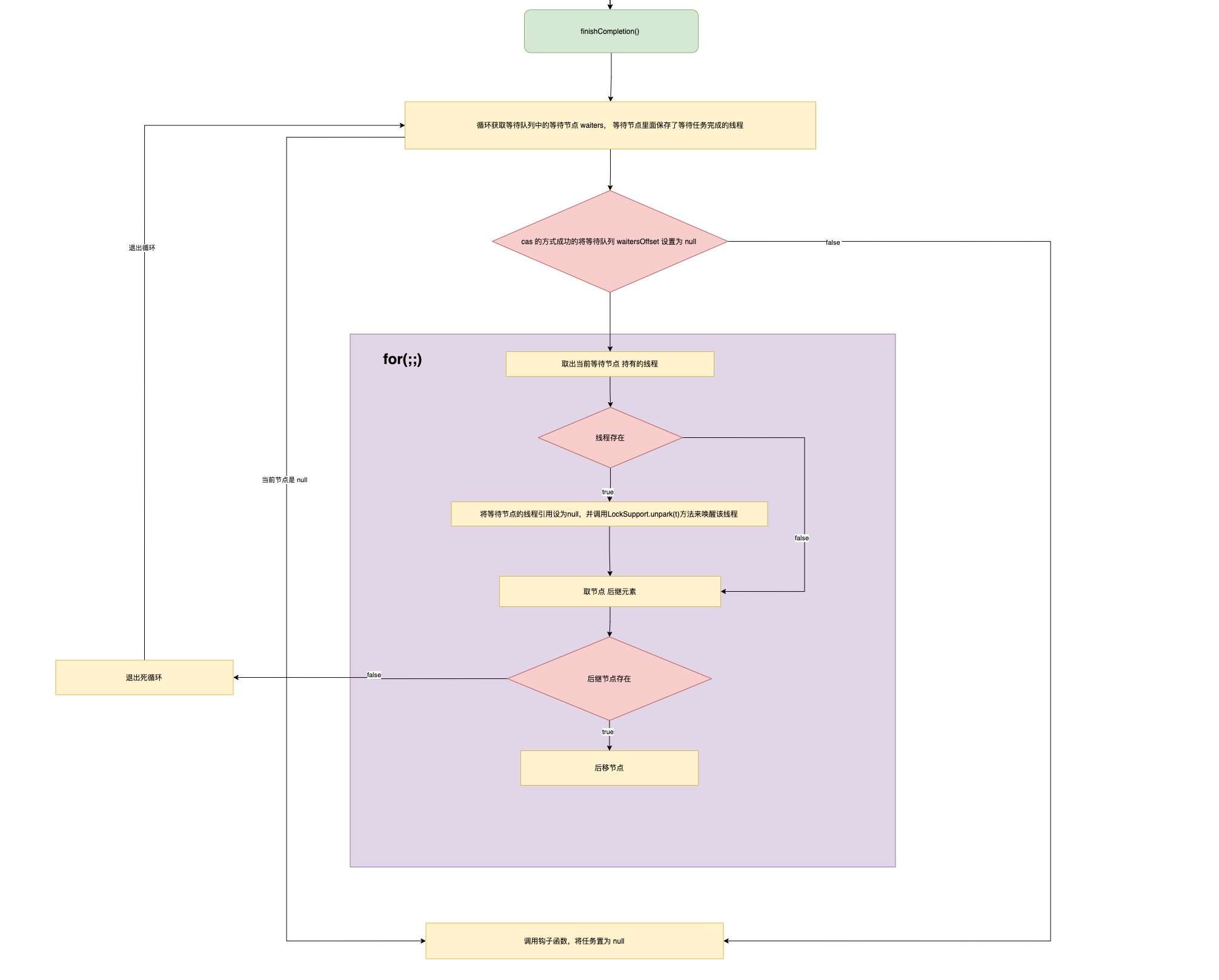
/**
* 移除并唤醒所有等待的线程,调用done()方法,并将callable置为null。
*/
private void finishCompletion() {
// assert state > COMPLETING;
// 循环获取等待队列中的等待节点 waiters, 等待节点里面保存了等待任务完成的线程
for (WaitNode q; (q = waiters) != null;) {
// 要是cas 的方式成功的将等待队列 waitersOffset 设置为 null
if (UNSAFE.compareAndSwapObject(this, waitersOffset, q, null)) {
// 循环处理每一个等待的节点
for (;;) {
// 取出当前等待节点 持有的线程
Thread t = q.thread;
// 线程存在
if (t != null) {
// 将等待节点的线程引用设为null,并调用LockSupport.unpark(t)方法来唤醒该线程
q.thread = null;
LockSupport.unpark(t); //LockSupport.unpark(t)方法用于唤醒一个被阻塞的线程。
}
WaitNode next = q.next; // 取节点下一个元素
if (next == null)// 要是没有后继节点,此时表示已经处理完所有等待节点,退出 死循环
break;
// 将后继节点置为 null
q.next = null; // unlink to help gc
// 节点后移
q = next;
}
break; // (q = waiters) == null 退出循环
}
}
done(); // 调用done()方法来完成任务的执行 —————— 钩子方法
/*
这段代码是一个保护(protected)方法,当任务转换为已完成状态(isDone)时被调用,无论是正常完成还是通过取消完成。
默认实现不执行任何操作。子类可以重写这个方法来调用完成回调或进行记录。
注意,在该方法的实现中,您可以查询状态来确定任务是否已被取消。
protected void done() { }
*/
callable = null; // to reduce footprint 将callable引用设为null,以减少内存占用。
}
runAndReset()
任务可以执行多次
- 和 run() 的区别就是 没有正常的结果设置结果集
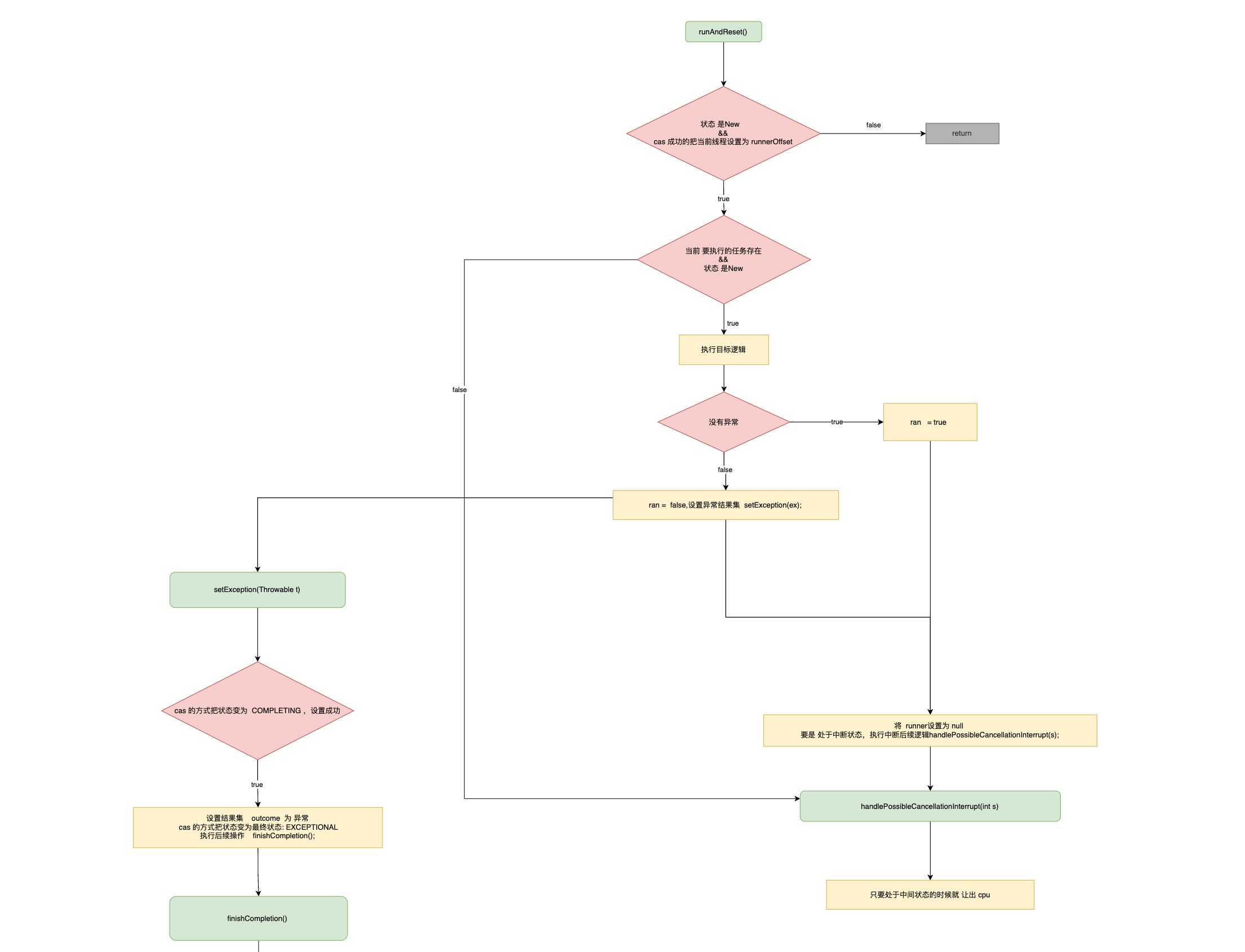
/**
执行计算,但不设置其结果,然后将该Future重置为初始状态。
如果计算遇到异常或被取消,则无法执行重置操作。这个方法设计用于那些本质上需要执行多次的任务。
*/
// 执行并重置任务
protected boolean runAndReset() {
if (state != NEW ||!UNSAFE.compareAndSwapObject(this, runnerOffset,null, Thread.currentThread()))
return false;
boolean ran = false;
int s = state;
try {
Callable<V> c = callable;
if (c != null && s == NEW) {
try {
c.call(); // don't set result
ran = true;
} catch (Throwable ex) {
setException(ex);
}
/*
和 run() 的区别就是 没有正常的结果设置结果集
*/
}
} finally {
// runner must be non-null until state is settled to
// prevent concurrent calls to run()
runner = null;
// state must be re-read after nulling runner to prevent
// leaked interrupts
s = state;
if (s >= INTERRUPTING)
handlePossibleCancellationInterrupt(s);
}
return ran && s == NEW;
}
get()
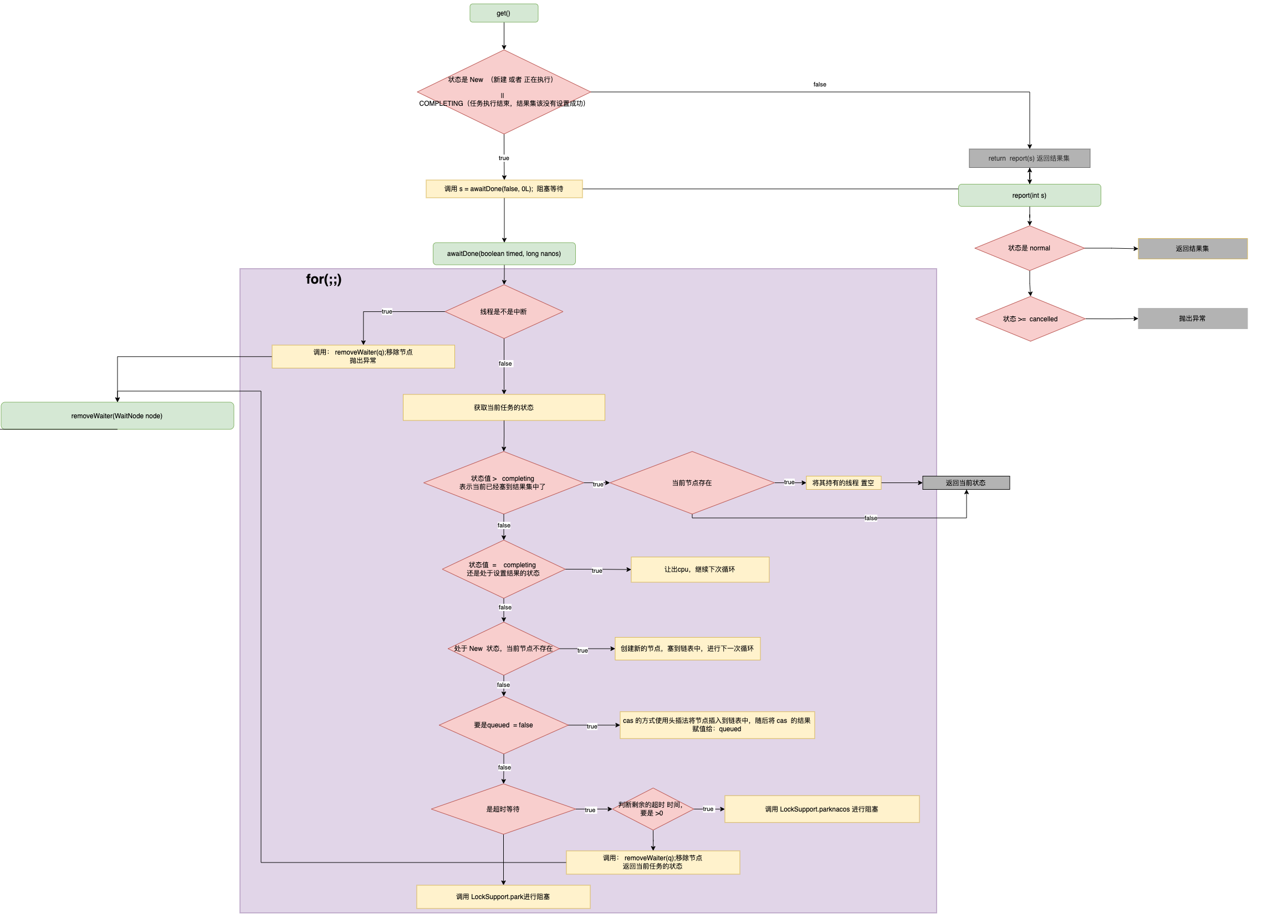
/**
* 如果计算被取消 会抛出异常
*/
public V get() throws InterruptedException, ExecutionException {
int s = state;
// 此时的状态只有 New (新建 或者 正在执行) 或者 COMPLETING(任务执行结束,结果集该没有设置成功)
if (s <= COMPLETING)
// 阻塞等待
s = awaitDone(false, 0L);
// 否则的话 返回结果集(正常 或者 异常)
return report(s);
}
/**
等待方法,根据传入的参数决定是否使用定时等待。如果使用定时等待,则会在指定的时间内 等待完成 或者 在中断或超时时中止。
*/
private int awaitDone(boolean timed, long nanos)
throws InterruptedException {
final long deadline = timed ? System.nanoTime() + nanos : 0L;
WaitNode q = null;
boolean queued = false;
//[注:] 带有阻塞的都要有 死循环,防止虚假唤醒
for (;;) { // 死循环
if (Thread.interrupted()) { // 判断是不是中断
removeWaiter(q); // 移除节点
throw new InterruptedException(); // 抛错
}
int s = state;
if (s > COMPLETING) {// 此时结果设置成功
// 当前节点存在,将其持有的线程 置空
if (q != null)
q.thread = null;
// 返回结果,结束阻塞
return s;
}
// 还是在设置结果的状态,让出 cpu
else if (s == COMPLETING) // cannot time out yet
Thread.yield();
// 处于 new 状态
else if (q == null)
// 创建节点
q = new WaitNode();
// 插入链表
else if (!queued)
// cas 的方式 头插法
queued = UNSAFE.compareAndSwapObject(this, waitersOffset,q.next = waiters, q);
// 超时等待,
else if (timed) {
nanos = deadline - System.nanoTime();
// 时间已过,移除结果,返回状态
if (nanos <= 0L) {
removeWaiter(q);
return state;
}
LockSupport.parkNanos(this, nanos);
}
else
LockSupport.park(this);
}
}
/**
*完成任务之后 返回结果或者抛出异常
*/
@SuppressWarnings("unchecked")
private V report(int s) throws ExecutionException {
Object x = outcome;
if (s == NORMAL)
return (V)x;
if (s >= CANCELLED)
throw new CancellationException();
throw new ExecutionException((Throwable)x);
}
removeWaiter(WaitNode node)
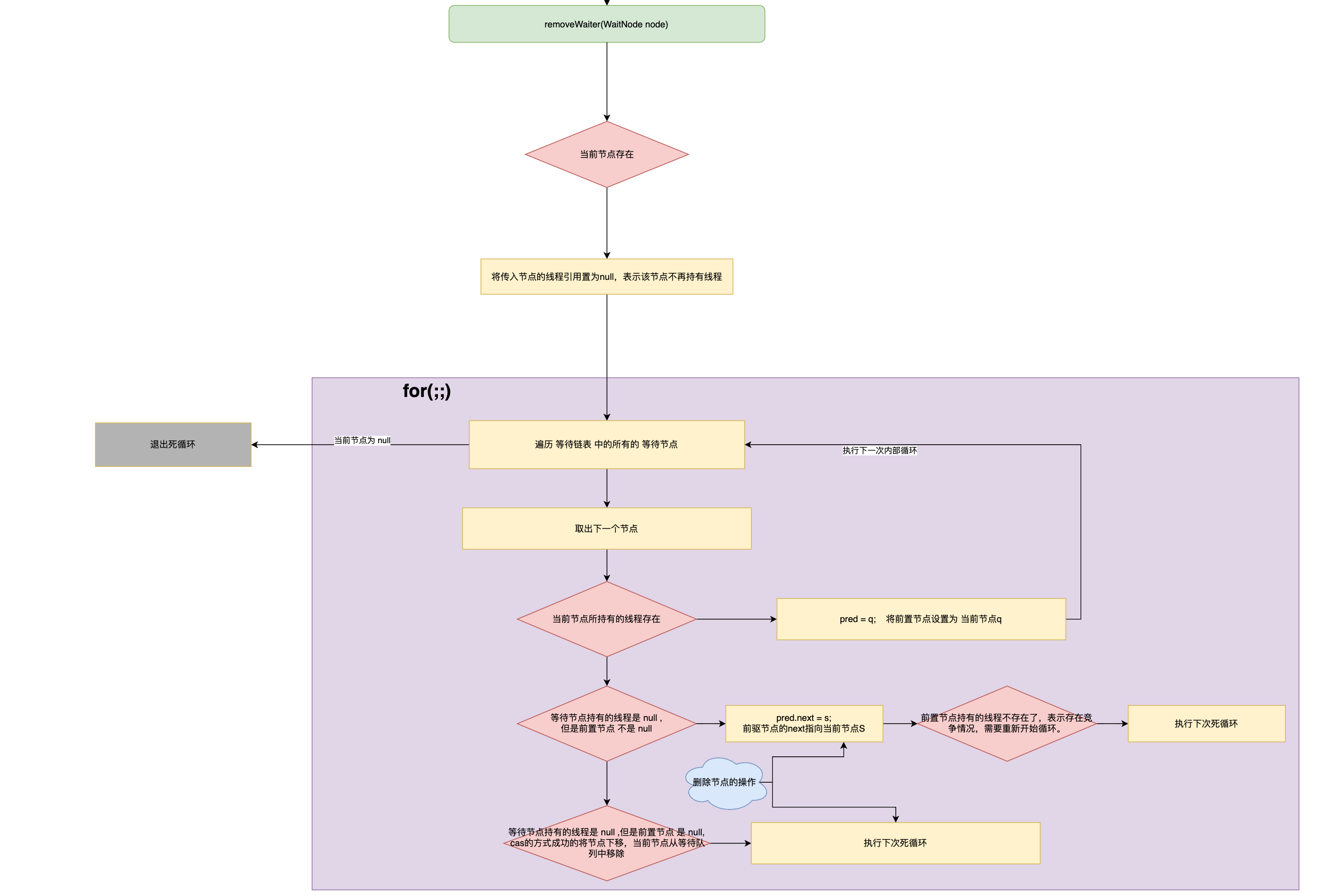
/**
* 尝试取消链接超时或中断的等待节点,以避免累积垃圾。
内部节点只是简单地取消拼接,而无需使用CAS,因为如果它们被释放器遍历,这样做是无害的。
为了避免从已经删除的节点中取消拼接的影响,在明显存在竞争的情况下,列表将被重新遍历。
当节点很多时,这会很慢,但我们不希望列表足够长以抵消更高开销的方案。
*/
private void removeWaiter(WaitNode node) {
if (node != null) {// 当前节点存在
// 将传入节点的线程引用置为null,表示该节点不再持有线程
node.thread = null;
retry:
// 死循环
for (;;) { // restart on removeWaiter race
// 遍历链表 中的所有的 等待节点
for (WaitNode pred = null, q = waiters, s; q != null; q = s) {
// 取出下一个节点
s = q.next;
// 要是此等待节点持有的线程不是 null
if (q.thread != null)
pred = q; // 将前置节点设置为 当前节点q
else if (pred != null) {// 等待节点持有的线程是 null ,但是前置节点 不是 null
// 前驱节点的next指向当前节点
pred.next = s;
// 前置节点持有的线程不存在了,表示存在竞争情况,需要重新开始循环。执行下次死循环
if (pred.thread == null) // check for race
continue retry;
}
//等待节点持有的线程是 null ,但是前置节点 是 null, cas的方式成功的将节点下移,当前节点从等待队列中移除,执行下次死循环
// cas的方式将waitersOffset处的值从q替换为s
else if (!UNSAFE.compareAndSwapObject(this, waitersOffset,q, s))
continue retry;
}
// 内层遍历结束,等待集合中没有无效节点
break;
}
}
}
get(long timeout, TimeUnit unit)
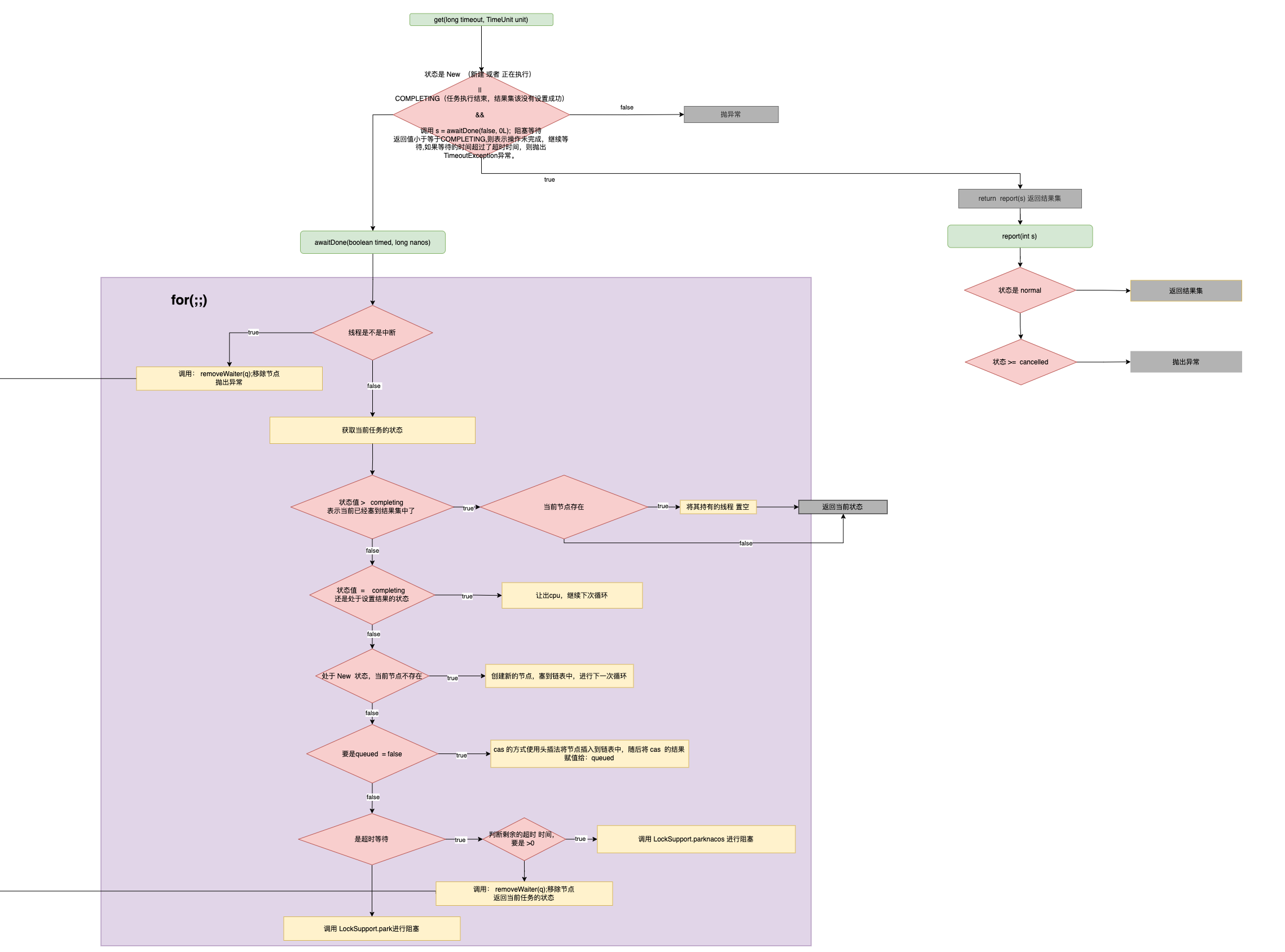
public V get(long timeout, TimeUnit unit)
throws InterruptedException, ExecutionException, TimeoutException {
if (unit == null)
throw new NullPointerException();
int s = state; // 获取当前对象的状态
// 调用awaitDone方法来等待操作完成,如果返回的状态值小于等于COMPLETING,则表示操作未完成,继续等待,如果等待的时间超过了超时时间,则抛出TimeoutException异常。
if (s <= COMPLETING && (s = awaitDone(true, unit.toNanos(timeout))) <= COMPLETING)
throw new TimeoutException();
//将最终的状态值作为参数传递给report方法,并返回report方法的返回值。
return report(s);
}
cancel()
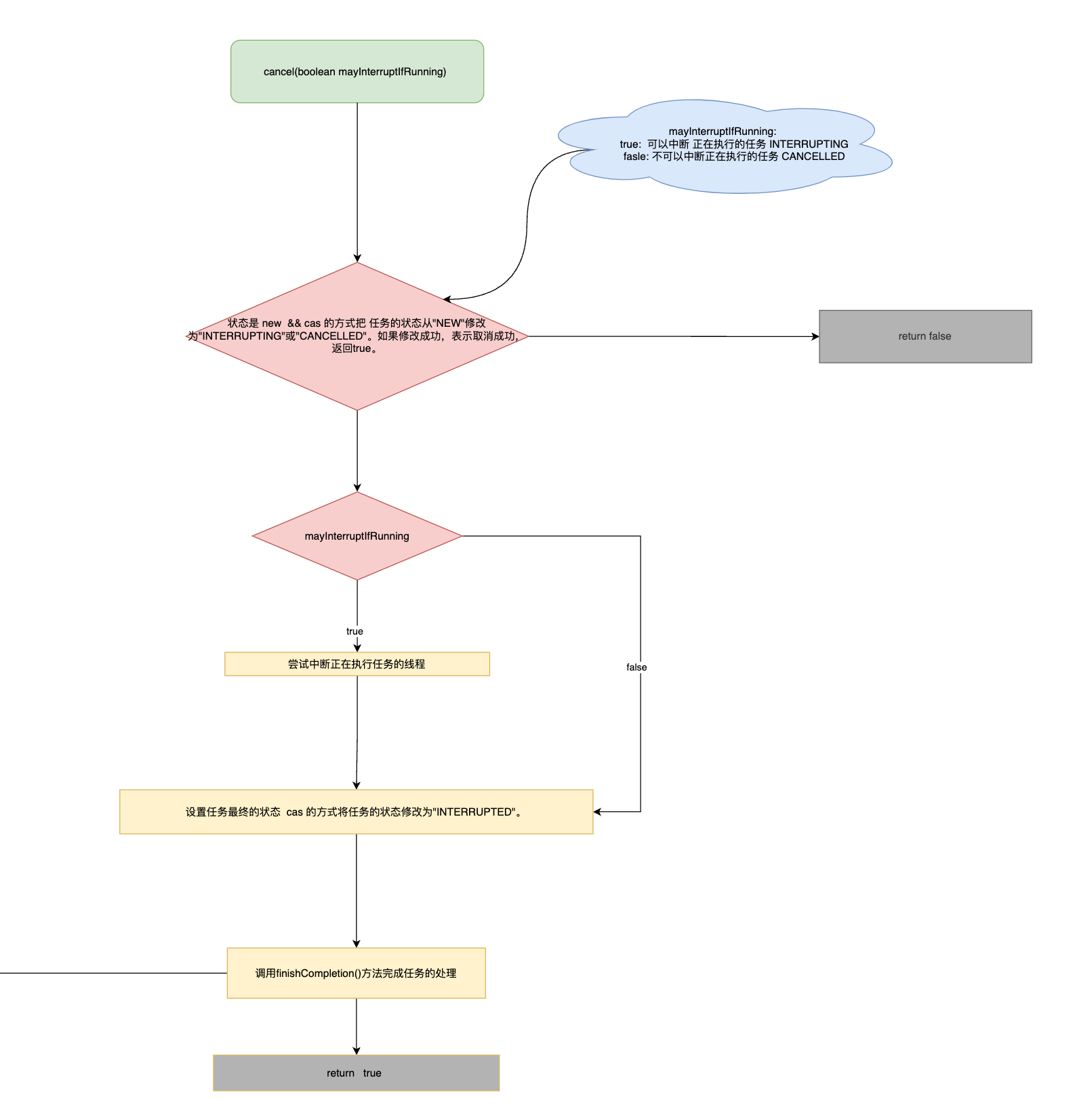
public boolean cancel(boolean mayInterruptIfRunning) {
if (!(state == NEW &&UNSAFE.compareAndSwapInt(this, stateOffset, NEW,mayInterruptIfRunning ? INTERRUPTING : CANCELLED)))
return false;
/*
mayInterruptIfRunning:
true: 可以中断正在执行的任务 INTERRUPTING
fasle: 不可以中断正在执行的任务 CANCELLED
*/
// 状态是 new ;cas 的方式把 任务的状态从"NEW"修改为"INTERRUPTING"或"CANCELLED"。如果修改成功,表示取消成功,返回true。
try { // in case call to interrupt throws exception
if (mayInterruptIfRunning) {
try {
Thread t = runner; // 尝试中断正在执行任务的线程
if (t != null) // 如果任务的runner不为null,则调用interrupt()方法中断线程。
t.interrupt();
} finally { // final state
// 设置任务最终的状态 cas 的方式将任务的状态修改为"INTERRUPTED"。
UNSAFE.putOrderedInt(this, stateOffset, INTERRUPTED);
}
}
} finally {
// 调用finishCompletion()方法完成任务的处理
finishCompletion();
}
return true; //返回true表示取消成功。
}
手撕FutureTask:
import java.util.ArrayList;
import java.util.List;
import java.util.concurrent.locks.LockSupport;
public class FutureTask_<T> implements Runnable {
private Future_<T> future;
public FutureTask_(Future_<T> future) {
this.future = future;
}
public FutureTask_(Runnable runnable) {
this.future = new FutureAdaptive(runnable);
}
@Override
public void run() {
try{
res = this.future.code();
state = 1;
}catch (Exception e){
res = e;
state = 2;
}
for (Thread thread : threadList){
LockSupport.unpark(thread); // 唤醒
}
}
private Object res;
private volatile int state;
private List<Thread> threadList = new ArrayList<>();
public T get(){
for (;;){
if(state == 0){
threadList.add(Thread.currentThread());
LockSupport.park(); // 阻塞
}else if(state == 1){
return (T)res;
}else if(state == 2){
throw new RuntimeException(res.toString());
}
}
}
private class FutureAdaptive implements Future_<T> {
public Runnable runnable;
public FutureAdaptive(Runnable runnable) {
this.runnable = runnable;
}
@Override
public T code() throws Exception {
this.runnable.run();
return null;
}
}
}
class MM {
public static void main(String[] args){
Future_<String> future = new Future_<String>() {
@Override
public String code() throws Exception {
return "future";
}
};
Runnable runnable = new Runnable(){
@Override
public void run() {
System.out.println("runnable");
}
};
FutureTask_<String> future_ = new FutureTask_<String>(future);
FutureTask_<String> runnable_ = new FutureTask_<String>(runnable);
new Thread(future_).start();
new Thread(runnable_).start();
System.out.println(future_.get());
LockSupport.parkNanos(2*1000*1000*1000);
}
}
interface Future_<T>{
T code() throws Exception;
}
文章来源:https://blog.csdn.net/m0_49867458/article/details/135188188
本文来自互联网用户投稿,该文观点仅代表作者本人,不代表本站立场。本站仅提供信息存储空间服务,不拥有所有权,不承担相关法律责任。 如若内容造成侵权/违法违规/事实不符,请联系我的编程经验分享网邮箱:veading@qq.com进行投诉反馈,一经查实,立即删除!
本文来自互联网用户投稿,该文观点仅代表作者本人,不代表本站立场。本站仅提供信息存储空间服务,不拥有所有权,不承担相关法律责任。 如若内容造成侵权/违法违规/事实不符,请联系我的编程经验分享网邮箱:veading@qq.com进行投诉反馈,一经查实,立即删除!